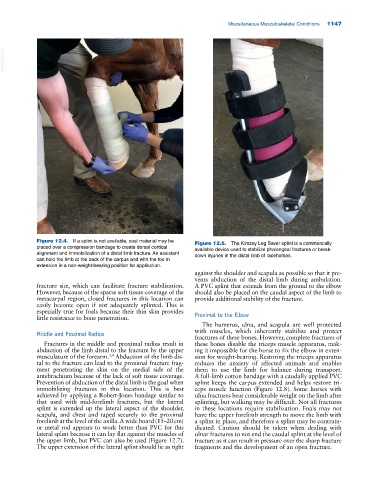Page 1181 - Adams and Stashak's Lameness in Horses, 7th Edition
P. 1181
Miscellaneous Musculoskeletal Conditions 1147
VetBooks.ir
Figure 12.4. If a splint is not available, cast material may be Figure 12.5. The Kimzey Leg Saver splint is a commercially
placed over a compression bandage to create dorsal cortical available device used to stabilize phalangeal fractures or break-
alignment and immobilization of a distal limb fracture. An assistant down injuries in the distal limb of racehorses.
can hold the limb at the back of the carpus and with the toe in
extension in a non‐weight‐bearing position for application.
against the shoulder and scapula as possible so that it pre
vents abduction of the distal limb during ambulation.
fracture site, which can facilitate fracture stabilization. A PVC splint that extends from the ground to the elbow
However, because of the sparse soft tissue coverage of the should also be placed on the caudal aspect of the limb to
metacarpal region, closed fractures in this location can provide additional stability of the fracture.
easily become open if not adequately splinted. This is
especially true for foals because their thin skin provides Proximal to the Elbow
little resistance to bone penetration.
The humerus, ulna, and scapula are well protected
Middle and Proximal Radius with muscles, which inherently stabilize and protect
fractures of these bones. However, complete fractures of
Fractures in the middle and proximal radius result in these bones disable the triceps muscle apparatus, mak
abduction of the limb distal to the fracture by the upper ing it impossible for the horse to fix the elbow in exten
musculature of the forearm. Abduction of the limb dis sion for weight‐bearing. Restoring the triceps apparatus
3,4
tal to the fracture can lead to the proximal fracture frag reduces the anxiety of affected animals and enables
ment penetrating the skin on the medial side of the them to use the limb for balance during transport.
antebrachium because of the lack of soft tissue coverage. A full‐limb cotton bandage with a caudally applied PVC
Prevention of abduction of the distal limb is the goal when splint keeps the carpus extended and helps restore tri
immobilizing fractures in this location. This is best ceps muscle function (Figure 12.8). Some horses with
achieved by applying a Robert‐Jones bandage similar to ulna fractures bear considerable weight on the limb after
that used with mid‐forelimb fractures, but the lateral splinting, but walking may be difficult. Not all fractures
splint is extended up the lateral aspect of the shoulder, in these locations require stabilization. Foals may not
scapula, and chest and taped securely to the proximal have the upper forelimb strength to move the limb with
forelimb at the level of the axilla. A wide board (15–20 cm) a splint in place, and therefore a splint may be contrain
or metal rod appears to work better than PVC for this dicated. Caution should be taken when dealing with
lateral splint because it can lay flat against the muscles of ulnar fractures to not end the caudal splint at the level of
the upper limb, but PVC can also be used (Figure 12.7). fracture as it can result in pressure over the sharp fracture
The upper extension of the lateral splint should lie as tight fragments and the development of an open fracture.

